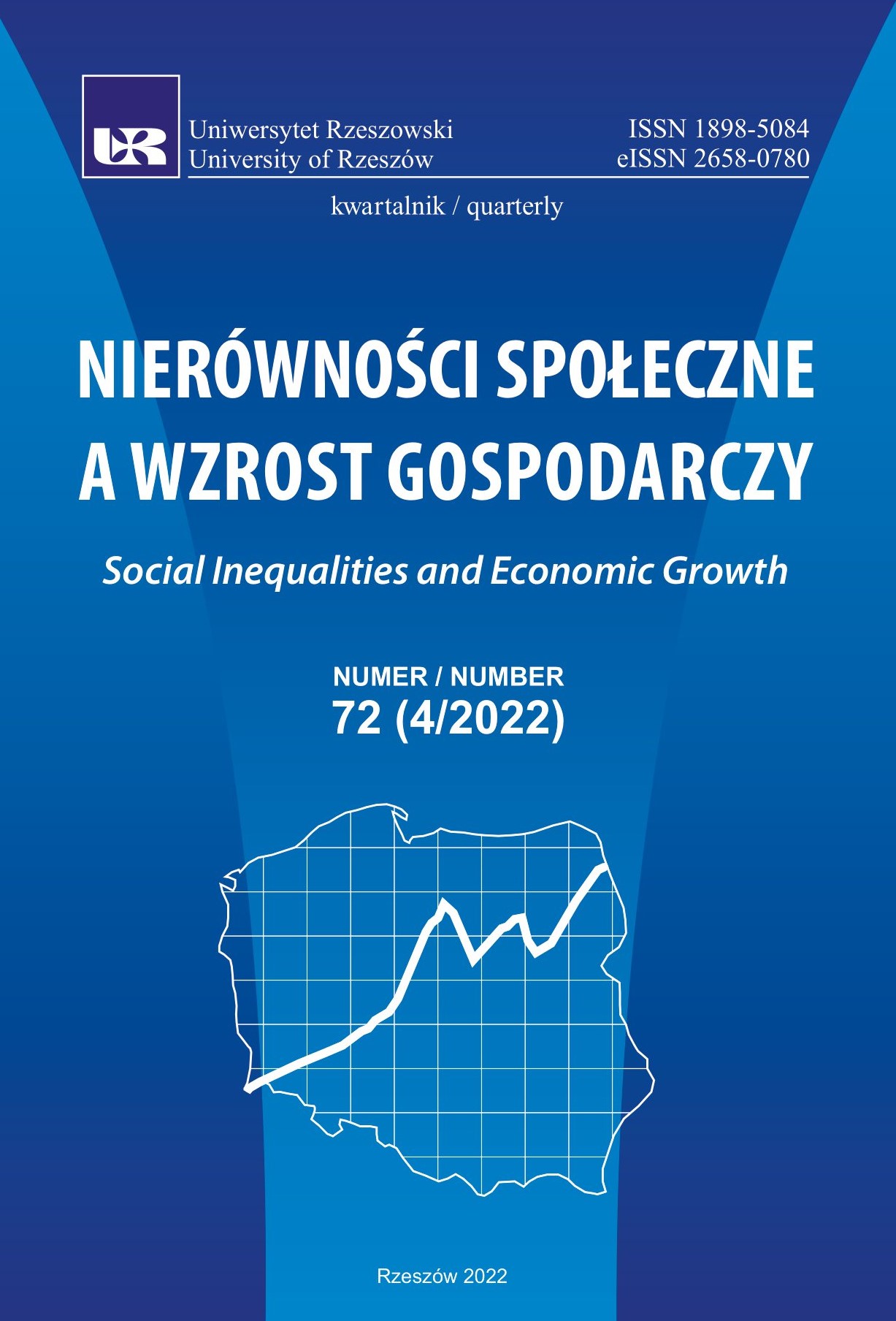Dywergencja gospodarcza Polski i Ukrainy z perspektywy ich bilansów płatniczych
DOI:
https://doi.org/10.15584/nsawg.2022.4.4Słowa kluczowe:
dywergencja ekonomiczna pomiędzy Polską i Ukrainą, wzrost gospodarczy Polski i Ukrainy, bilans płatniczy, inwestycje bezpośrednieAbstrakt
Artykuł ma na celu analizę zjawiska dywergencji gospodarczej Polski i Ukrainy z perspektywy dynamiki bilansów płatniczych obu krajów. W artykule zakłada się, że różnice w ścieżkach rozwoju gospodarczego znajdują odzwierciedlenie w przepływach bieżących i finansowych, które są rejestrowane w bilansach płatniczych.
Testowanie potencjalnych determinant dywergencji gospodarczej pomiędzy Polską a Ukrainą wynikających z ich bilansów płatniczych zostało oparte na jednowymiarowych regresjach liniowych. Badanie przeprowadzono na podstawie rocznych danych pozyskanych z Banku Światowego (WDI) za lata 1995–2001.
Stwierdzono istotny pozytywny związek między dynamiką dywergencji gospodarczej między Polską a Ukrainą a dynamiką (i) otwartości handlowej, (ii) sald handlu i usług, (iii) transferów kapitałowych, (iv) zobowiązań z tytułu bezpośrednich inwestycji zagranicznych oraz (v) aktywów z tytułu bezpośrednich inwestycji zagranicznych. Dynamika różnic w rachunkach pierwotnych i wtórnych między obydwoma krajami była z kolei ujemnie skorelowana z poziomem dywergencji między Polską a Ukrainą. Większe różnice między PKB Polski i Ukrainy wystąpiły pomimo pogarszającego się stanu rachunku pierwotnego w Polsce i pomimo dużego napływu transferów bieżących odnotowanych na rachunku wtórnym na Ukrainie.
Downloads
Bibliografia
Andrzejczak, M. (2019). Capital transfers and external balance in post-accession Poland. Studia Oeconomica Posnaniensia, 7(4), 59–74. DOI: 10.18559/SOEP.2019.4.4.
Arii, A., Pula, G. (2021). Assessing the Macroeconomic Impact of Structural Reforms in Ukraine. IMF Working Paper International Monetary Fund, 21/100, 1–31.
Åslund, A. (2009). How Ukraine Became a Market Economy and Democracy. Washington, DC.: Peterson Institute for International Economics.
Åslund, A. (2013). How Capitalism Was Built: The Transformation of Central and Eastern Europe, Russia, and the Caucasus, and Central Asia. Cambridge: Cambridge University Press.
Baszczak, Ł. (2020). Why is Ukraine poorer than Poland? Klub Jagielloński. Retrieved from: https://klubjagiellonski.pl/2020/09/24/why-is-ukraine-poorer-than-poland/ (2022.09.15).
Balabushko, O., Beer, S., Loeprick, J., Pinto Vallada, F. (2017). The Direct and Indirect Costs of Tax Treaty Policy Evidence from Ukraine. Policy Research Working Paper, 7982, 1–33.
Bartz, L. (2015). Post-Soviet Economic Development in Poland and Ukraine: Common Trials, Divergent Paths. Retrieved from: https://ou.edu/content/dam/cas/economics/Student%20Journal%20of%20Economics%20publications/Luke%20Bartz3_PostSovietJOE.pdf (2022.09.15).
Belka, M. (2013). How Poland’s EU Membership Helped Transform its Economy. Occasional Paper, 88, 1–76.
Bilenko, Y. (2013). Economic and institutional fundamentals of the divergence of development paths in Central and Eastern Europe. Ekonomika, 92(3), 24–40.
Chugaievska, S., Wisła, R., Nowosad, A. (2020). Ownership transformations in Poland and Ukraine. In: E. Wisła, A. Nowosad (eds.), Economic Transformation in Poland and Ukraine, National and Regional Perspectives (pp. 25–40). London and New York: Routledge.
EBA. (2020). Foreign Investor Survey. Retrieved from: https://eba.com.ua/wp-content/uploads/2020/11/2020_ForeignInvestorSurvey_Presentation_en.pdf (2022.09.15).
Hartwell, C.A. (2014). Poland and Ukraine: A Portrait in Divergence, FOR. Retrieved from: https://for.org.pl/pliki/artykuly/2010_1333-analiza-17-2014-poland-and-ukraine-a-portrait-in-divergence.pdf (2022.09.20).
Hartwell, C.A. (2016). Two Roads Diverge: The Transition Experience of Poland and Ukraine, Cambridge: Cambridge University Press.
IMF. (2009). Balance of Payments Manual. Retrieved from: https://www.imf.org/external/pubs/ft/bopman/bopman.pdf (2022.09.15).
IMF. (2021). Ukraine. First review under the stand-by arrangement, requests for extension and rephasing of access of the arrangement, waivers of nonobservance of a performance criterion, financing assurances review, and monetary policy consultation. IMF Country Report, No. 21/250.
Kowalski, T., Shachmurove, Y. (2018). Economic development in Poland and Ukraine: The case of foreign trade. Interdisciplinary Journal of Economics and Business Law, 7, 35–61.
Lukanienko, D. (2013). Evolution of the economic model in Ukraine. Background and Specific Features of Market Transformation. In: D. Lukanienko, V. Chuzhykov, M.G. Woźniak (eds.), Convergence and Divergence in Europe: Polish and Ukrainian Cases (pp. 314–404). Kiev: KNEU.
Mykhnenko, V. (2007). Strengths and Weaknesses of ‘Weak’ Coordination: Economic Institutions, Revealed Comparative Advantages, and Socio-Economic Performance of Mixed Market Economies in Poland and Ukraine. In: B. Hancké, M. Rhodes, M. Thatcher (eds.), Beyond Varieties of Capitalism: Conflict, Contradictions, and Complementarities in the European Economy (pp. 351–378). Oxford: Oxford University Press.
NBP. (2018). Statystyka bilansu płatniczego. Uwagi metodyczne. Warszawa: Departament Statystyki NBP.
Rushchyshyn, N., Mulska, O., Nikolchuk, Y., Rushchyshyn, M., Vasyltsiv, T. (2021). The impact of banking sector development on economic growth: Comparative analysis of Ukraine and some EU countries. Investment Management and Financial Innovations, 18(2), 193–208. DOI: 10.21511/imfi.18(2).2021.16.
Saha, D., Kravchuk, V., Kirchner, R. (2018). The Economic impact of FDI on Ukraine. Policy Studies Series,1, 1–51.
Smits, K., Favaro, E.M., Golovach, A., Khan, F., Larson, D.F., Schroeder, K.G., Schmidt, G., Nivievskyi, O., Osmochescu, E., Ponomarenko, H., Cuaresma, J.C., Oberhofer, H., Hrebeniuk, Y., Ek, C.C. (2019). Ukraine Growth Study Final Document: Faster, Lasting and Kinder. Washington, D.C.: World Bank Group. Retrieved from: http://documents.worldbank.org/curated/en/543041554211825812/Ukraine-Growth-Study-Final-Document-Faster-Lasting-and-Kinder (2022.09.02).
Sutela, P. (2012). The Political Economy of Putin’s Russia. Abingdon: Routledge.
Tilford, S. (2014). Poland and Ukraine: A tale of two economies. CER Bulletin, 95. Retrieved from: https://www.cer.org.uk/sites/default/files/publications/attachments/pdf/2014/bulletin_95_st_article1-8624.pdf (2022.09.20).
Vakhitova, H., Fihel, A. (2020). International Migration from Ukraine: Will Trends Increase or Go into Reverse? Central and Eastern European Migration Review, 9(2), 125–141.
WDI. World Development Indicators, The World Bank. Retrieved from: https://databank.worldbank.org/source/world-development-indicators (2022.09.02).
Wisła, R., Chugaievska, N., Nowosad, A., Turanli, U. (2020). Structural changes in the Polish and Ukrainian economies against the background of other Central and Eastern European countries. In: E. Wisła, A. Nowosad (eds.), Economic Transformation in Poland and Ukraine, National and Regional Perspectives (pp.42–56). London and New York: Routledge.
World Bank. (2019). The World Bank Annual Report 2019: Ending Poverty, Investing in Opportunity. Washington, DC: World Bank. Retrieved from: https://openknowledge.worldbank.org/handle/10986/32333 (2022.09.02).
Pobrania
Opublikowane
Jak cytować
Numer
Dział
Licencja
Prawa autorskie (c) 2023 Uniwersytet Rzeszowski

Utwór dostępny jest na licencji Creative Commons Uznanie autorstwa – Na tych samych warunkach 4.0 Miedzynarodowe.


